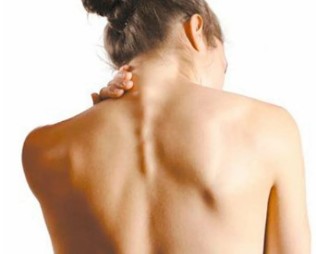Cervical back pain is a disease of the intervertebral discs of the cervical spine (usually C5, C6, and C7), wear degenerative-degenerative nature and characterized by the growth of bone tissue in the cervical region of the spine. Formed on the vertebrae osteophytes (limestone, growths) irritate the muscles, which leads to their reflected compression and an increase in the pressure on the vertebrae. Consequently, the intervertebral discs are compressed, their thickness is reduced, which also contributes to the compression, vertebral artery, and the denial of the nerve endings in the curve of the head.

For these reasons, cervical back pain is a very dangerous disease. It stops the flow of blood to the brain and causes hypoxia parts of the brain, with possible complications.
The danger of cervical arthrosis
Cervical back pain — a serious disease, the symptoms of which are not limited to pain in the cervical area with a movement of the head. In the absence of treatment with the development of the disease the patient is facing a lot of complications that expresses considerable discomfort and may be due to different dysfunctions of the body.
The violation of the artery, which occurs due to the fact that the vertebrae are deformed and come closer together, leading to the so-called vertebral-basilar syndrome. Insufficient blood supply to the brain causes disturbances of balance, dizziness, a regular, or permanent damage of view, the appearance of the noise in the ears, semiconscious state, and loss of consciousness. Depending on the degree of displacement of the artery in the cervical spine and of the characteristics of the body, the consequences can manifest themselves in different degrees of severity and match between them.
Violation occipital nerve with osteochondrosis of the cervical becomes the cause of constant migraines, favouring the neck and the head. The most dangerous is the violation of the spinal cord and its neural processes. May experience serious malfunctions that occur in the case of violation of the coordination of the limbs, their sensitivity, loss of strength. Also the patient may have difficulty with control of bladder and bowel, often observed spastic involuntary movements of the legs.
Without the treatment of back pain, cervical leads to complications — for example, the protrusion and hernia of the intervertebral disc of the cervical spine. This also favours the birth and the development of cardiovascular diseases, which cause various disorders of the brain up to the death of some of its phases.
Causes of osteoarthritis cervical spine
Even if traditional medicine treats degenerative changes of the intervertebral disc of cervical disease, from the point of view of osteopathy is only the manifestation of deeper disturbances of the body.
In this way, the true causes of degenerative disease of the cervical disc are:
- Disorders of posture. Scoliosis, stoop, round back, kyphosis, and other disorders of posture, even if they bring a light character, causing a serious breach of balance of the spine. Consequently, the load on the intervertebral discs is distributed unevenly, which can lead to distortion and increased wear. The vertebrae begin to converge, causing a breach in neural processes, rather, it is developing rapidly cervical back pain. Similar effects are and disorders of posture, caused by the change in the natural position of the flaps.
- Muscle spasms. The spasmodic reaction of the muscles of the back, chest, abdominal can lead to the fact that some parts of the body are found to be very tense. The result is a broken general the position of equilibrium of the body, causing the change of position of the spine. The deformation can touch the cervical area or other parts of the spine, causing back pain breast, cervical, and lumbar.
- Circulatory disorders. As well as the vertebral disks do not have a direct connection with the circulatory system, the food obtained of the surrounding tissues. Circulatory disorders of the cervical leads to the fact that the discs do not receive enough fluid for rehydration (recovery of the shape due to the absorption of humidity), the update of the cartilage tissue. Hence, their wear is accelerated, there is a reduction of the distances between the vertebrae of the cervical spine, resulting in osteochondrosis.
- The violation of innervation. Decrease in the sensitivity of the nerve roots leads to pathological alterations in their structure, with consequent displacement and deformation of the vertebrae and cervical remains unnoticed by the patient. Because the pain is not present due to disorders of sensitivity.
- Diseases of the internal organs. The wrong position of the internal organs, their movement and sag due to several dysfunction leads to disruption of the overall balance of the body. The result is a marked effect on the position of the spine — cervical, lumbar vertebrae move and deform, resulting in the corresponding types of degenerative disc disease.
In general, the back pain cervical develops due to adverse effects of external factors, which violate the natural equilibrium position of the spine and other systems of the human body. Often these disorders become evident from the beginning, cervical and low back pain progresses, leading to serious consequences. It is therefore important to attend regular osteopath, who will be able to solve exactly the causes of the back pain cervical vertebra, and not give the treatment of the symptoms, like traditional medicine.
Signs of cervical arthrosis
Depending on which affects the vertebrae of the cervical back pain, the symptoms can manifest themselves in a different way. But if you have at least one, that is, to suspect back pain of the cervical spine, so it makes sense to use a specialist for a thorough check and diagnosis. The main signs of cervical arthrosis of the spine:
- The sensation of pain. The first symptom is pain, which in the early stages manifests itself only when you rotate and tilt the head. Discomfort are usually localized to the right or the left the cervical spine, sometimes the symptoms include, and the surrounding areas. With the development of cervical arthrosis, the pain radiates to the occipital and frontal of the head, takes on the character of migraine.
- The deterioration of the organs of the senses. Above all, they begin to experience problems with the view. Bright symptoms — blurred vision, double vision, darkening in the eyes, wear the regular forecast, there is often noise in the ears.
- Vertigo. Almost always, back pain, cervical is accompanied by a characteristic vertigo, presenting with a sudden movement or turn of the head, slopes, changing position. Can occur nausea and vomiting.
- Fainting. State of semicoscienza and loss of consciousness are a common symptom later stages of cervical osteoarthritis. Some patients these symptoms can also occur when the initial development of the disease;
- Kardialgija. Together with other symptoms often there are feelings, open to attacks of angina;
- Disorders of sensitivity. Depending on which vertebrae are affected the neck osteochondrosis, a sign of the presence of the disease becomes a partial loss of sensitivity in the occipital and parietal head, frozen in the field, the forearm. In some cases, numbness may spread from the neck to the arm to the little finger or thumb, respectively, to the outer or the outer part of the limb;
- Disorder of language. It is not a very common symptom and occurs due to the loss of control of the tongue, due to squeezing of the nerve roots C3 and C4. Also in this case, you may experience difficulty breathing.
Usually the symptoms, which is characterized by back pain cervical, appear bright enough — either singly or in combination. Then diagnose possible even alone. At the first sign it is recommended that you consult a specialist-the osteopath for cervical back pain, symptoms, and treatment — one of the sectors of professional activity.

Osteopathic treatment of degenerative disc disease of the cervical
Today, the osteopathic treatment of degenerative disc disease of the cervical is the most effective. It aims to eliminate the causes, and not only struggling with the symptoms that manifest in the form of deformation and protrusion of intervertebral discs.
Of front of neck osteochondrosis, a specialist osteopath first diagnoses the disease and its localization to the department of the neck, that is, determines which displaced vertebrae and deformed. This can be done as guided the symptoms of degenerative disc disease, and a manual examination of a patient.
The initial phase of the treatment of cervical osteoarthritis — for the relief of pain. Often their reason is a spasm in the neck, the treatment of which is carried out by a specialist. The spasmodic reaction of the muscular cervical in response to the violation of a general balance in the body, resulting in compression of the nerve roots. Therefore you experience pain in the cervical area (back pain).
Often the resolution of spasms and of itself is quite effective treatment of the cervical spine. By eliminating the muscle tension, the osteopath does not only relieve pain, but and normalize the position of the spinal column. Cervical with due treatment is provided in the position of equilibrium, and exhaust.
Already after a few sessions you osteopath signs of cervical arthrosis reduced to a minimum or disappear entirely. This is due to the normalization of the circulation, which often interfere with the muscle spasms. Cervical tract of the vertebral column and the intervertebral discs receive the normal power supply together with the blood, and consequently, low back pain, cervical vertebra retreats.
In the later stages of the disease, when the violations are global, and often affect other organs, you may need more complex and long-term treatment. In this expert is not only osteochondrosis of the spine, but and comorbidities and with erectile dysfunction, including the movement of internal organs, lack of oxygen to the brain, the breach processes in the spinal cord, etc.
Despite the severity of the disease, osteochondrosis of the cervical spine fairly well treated in exactly the techniques of osteopathy. But to consolidate the results achieved, but also to prevent complications and relapse of the disease of a specialist that are recommended for additional methods of THERAPY, the correction of diet, moderate physical exercise, massage and physiotherapy treatments.
Depending on the extent to which it is expressed and for what reasons has back pain, the treatment is chosen an expert individually. Depending on the result, the treatment can be regulated and integrated with other procedures, that helps in fast and effective healing osteochondrosis of the department.
Prevention of cervical arthrosis
If you have been diagnosed with "back pain cervical, the treatment can take a long time. Much easier to prevent this disease does not, leading a healthy lifestyle. To avoid a long and complex treatment of degenerative disc disease (which is usually for the later stages) can be quite simple methods of prevention.
Education correct posture from an early age helps to avoid the treatment of degenerative disc disease in adulthood. Very often this disease are affected employees, and sedentary lifestyles-conductive for a long time in the same location. To prevent osteoarthritis of the vertebrae, it is necessary to do regular exercise, changing the position of the body, run to the inclinations and head shots, moderately load the shoulder belt.
Sports activities aimed at the overall strengthening of the muscles, the joints, of the bones of the skeleton will significantly reduce the likelihood of the onset of degenerative disc disease of the lumbar or cervical spine.
Even if you already have a sore back (the symptoms are quite bright), exercises, prevention will help to alleviate the course of the disease. But you must remember that of themselves are not a cure. You must pass the technical training course-the osteopath. Follow-up of prevention will be the guarantee that the signs of the degenerative disc disease is not perform and the disease will not return.




























